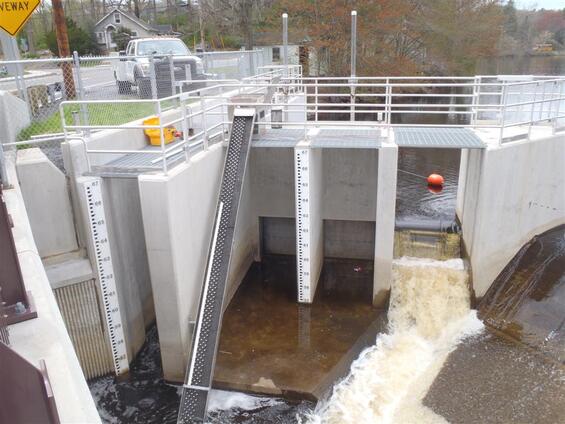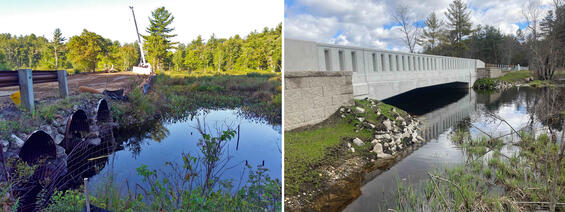Aquatic and wildlife connectivity

A bridge replacement project in Royalston. The bridge was replaced to increase its flood resiliency and provide wildlife passage using natural streambed material (left).
We are always looking for ways to improve the resiliency of transportation structures such as bridges and culverts. Replacing undersized culverts with larger bridge spans, restoring natural flow depths, and utilizing natural stream bed material protects the structure from flood damage. These techniques also create wildlife benches to allow a natural way for wildlife to pass through the structure, which reduces road mortality and provides habitat connectivity.

A view of the Morey's Dam fish ladder from the Bay Street Bridge in Taunton.
Many fish and aquatic organisms migrate between the ocean and freshwater habitats to spawn. Unfortunately, dams and undersized culverts can impede this process. We are committed to promoting the safe passage of aquatic organisms through our infrastructure by incorporating passageways such as eel and fish ramps, fish ladders, and fish passage weirs. For example, the Morey's Dam replacement in Taunton (pictured) included a fish and eel ladder. Passageways such as this fish and eel ladder supports fish populations that are critical to the Commonwealth's ecology and marine fisheries.

The historic culverts under Route-62 in Hubbardston were undersized and provided little room for safe wildlife passage. The culverts were replaced with a larger bridge span and turtle barriers including walls and fences were installed along the roadway to re-direct away from the roadway to reduce turtle mortality.
We also look for opportunities to reduce turtle roadway mortalities, especially for projects within turtle habitat protected by the state and/or federal Endangered Species Act. At a bridge and culvert replacement on State Route 62 in Hubbardston (pictured), improvements to turtle passage underneath the roadway were constructed. A short section of wall and fence were installed along the roadway to keep turtles off the road. In addition to safe passage installations, we also install turtle crossing signs along roadways to bring driver awareness to turtle crossing hotspots.
Reducing road mortality
Reducing wildlife vehicle collisions, improving public safety and landscape connectivity are priorities for us. Mitigation techniques fall into two categories: those that affect motorist behavior (lower speed limits and signs) and those that influence animal behavior (fencing, crossing structures and habitat modification). The function of passage structures is to get animals safely across a roadway, thereby facilitating natural movements and usually reducing road mortality. Location of passage structures are most effective where crossing points occur in areas with high wildlife activity. Wildlife crossing structures reduce wildlife-vehicle collisions, improve public safety, and provide greater habitat connectivity. Habitat modification and fencing can prevent wildlife from getting onto roadways, and can direct wildlife into safe passages such as culverts.
In 2015, a 1,000-foot Wildlife Culvert Passage was constructed under Route-2 in Concord, as part of the Route-2 Crosby Corner Safety Improvement Project. The 6.5ft. by 6.5ft.- culvert has been monitored using a MassDOT wildlife camera. Visitors (which can be seen in the photos above) include deer, fisher, gray fox, racoon, eastern painted turtle, and a bobcat.

The wildlife culvert passage under Route-2 in Concord allows wildlife to safely cross the road (left). A variety of wildlife has been documented using the wildlife passage including (left to right) deer, fisher cat, gray fox, and an elusive bobcat.
To improve public safety and driver awareness of moose, we partnered with Mass Wildlife to identify moose-crossing hotspots along routes 2 and 202 and other corridors where moose habitat caused high collision rates. New permanent moose crossing signs were installed by MassDOT and mobile LED message signs have been used during the September through November breeding season when moose are more active. The signs are meant to alert drivers to slow down. Although MassDOT signage is only placed along the documented moose crossing hotspots, moose are crossing roads over much of central and western Massachusetts. Drive slowly and be on the look-out from dusk till dawn, especially in the fall when breeding is in full swing. Always wear your seatbelt, and if you see a deer or moose crossing the road, safely hit the brakes.